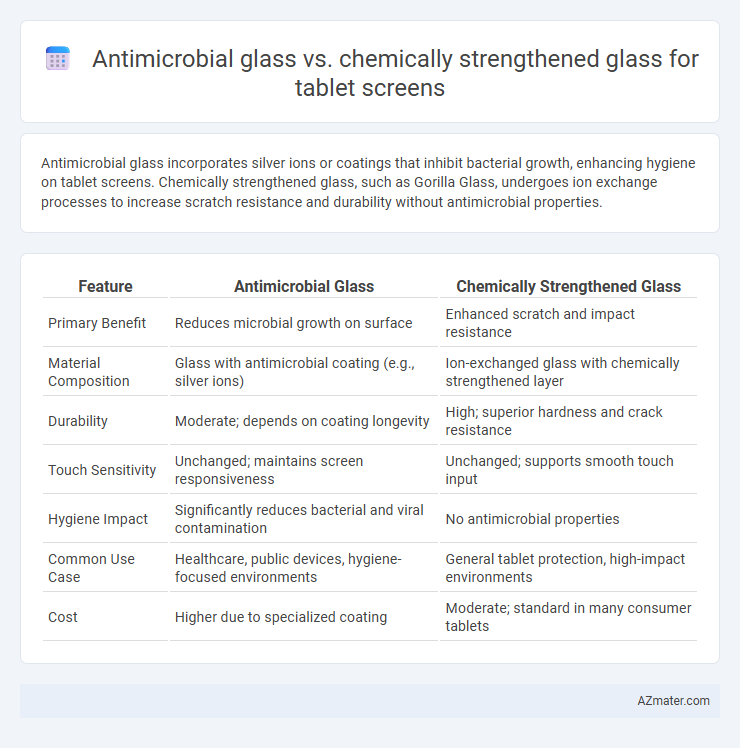Antimicrobial glass incorporates silver ions or coatings that inhibit bacterial growth, enhancing hygiene on tablet screens. Chemically strengthened glass, such as Gorilla Glass, undergoes ion exchange processes to increase scratch resistance and durability without antimicrobial properties.
Table of Comparison
| Feature | Antimicrobial Glass | Chemically Strengthened Glass |
|---|---|---|
| Primary Benefit | Reduces microbial growth on surface | Enhanced scratch and impact resistance |
| Material Composition | Glass with antimicrobial coating (e.g., silver ions) | Ion-exchanged glass with chemically strengthened layer |
| Durability | Moderate; depends on coating longevity | High; superior hardness and crack resistance |
| Touch Sensitivity | Unchanged; maintains screen responsiveness | Unchanged; supports smooth touch input |
| Hygiene Impact | Significantly reduces bacterial and viral contamination | No antimicrobial properties |
| Common Use Case | Healthcare, public devices, hygiene-focused environments | General tablet protection, high-impact environments |
| Cost | Higher due to specialized coating | Moderate; standard in many consumer tablets |
Introduction to Tablet Screen Glass Technologies
Antimicrobial glass for tablet screens integrates biocidal agents like silver ions to inhibit microbial growth, enhancing hygiene and reducing contamination risks in high-touch devices. Chemically strengthened glass undergoes an ion-exchange process, typically replacing smaller sodium ions with larger potassium ions, increasing surface compressive stress and improving resistance to scratches and impacts. Both technologies address durability and safety, with antimicrobial glass focusing on health protection while chemically strengthened glass prioritizes mechanical strength and fracture resistance.
Overview of Antimicrobial Glass
Antimicrobial glass for tablet screens integrates nanoscale silver ions or copper compounds that inhibit bacterial growth, providing hygienic and safer touch surfaces. This type of glass not only maintains high optical clarity and scratch resistance but also actively reduces microbial contamination, making it ideal for healthcare and public usage. Unlike chemically strengthened glass, which primarily enhances durability through ion exchange processes, antimicrobial glass targets cleanliness alongside protective functionality.
Overview of Chemically Strengthened Glass
Chemically strengthened glass for tablet screens undergoes an ion-exchange process that replaces smaller sodium ions with larger potassium ions, generating compressive stress on the surface to enhance durability and resistance to scratches and impacts. This type of glass offers improved toughness compared to standard glass and provides a clear, smooth touch interface essential for responsive screens. Though it lacks inherent antimicrobial properties, chemically strengthened glass ensures long-lasting protection against physical damage, maintaining screen integrity over extended device use.
Key Differences Between Antimicrobial and Chemically Strengthened Glass
Antimicrobial glass incorporates agents like silver ions or copper nanoparticles to inhibit the growth of bacteria and viruses on tablet screens, enhancing hygiene by reducing microbial contamination. Chemically strengthened glass is treated with ion exchange processes, such as potassium ion infusion, to increase surface compressive stress, resulting in superior resistance to scratches and mechanical impact without inherent antimicrobial properties. The primary distinction lies in antimicrobial glass's focus on health protection through microbial resistance, whereas chemically strengthened glass emphasizes structural durability and physical strength for tablet screen longevity.
Protection Against Germs: Efficacy of Antimicrobial Glass
Antimicrobial glass for tablet screens integrates ions like silver or copper that actively inhibit bacterial and viral growth, providing continuous protection against germs. Chemically strengthened glass enhances durability and resistance to impact and scratches but lacks inherent antimicrobial properties. For users prioritizing hygiene, antimicrobial glass offers superior germ protection by reducing microbial contamination on touchscreen surfaces.
Durability and Scratch Resistance: Strengthened Glass Performance
Antimicrobial glass for tablet screens offers enhanced protection against bacteria and germs, but chemically strengthened glass outperforms it in durability and scratch resistance due to processes like ion exchange that increase surface strength. Chemically strengthened glass, such as Gorilla Glass, exhibits superior impact resistance and maintains clarity by effectively minimizing micro-scratches from daily use. In contrast, antimicrobial coatings may wear off over time, reducing their protective benefits without significantly improving the glass's physical durability or scratch resistance.
Impact on Touch Sensitivity and Display Quality
Antimicrobial glass offers enhanced protection against bacteria without compromising touch sensitivity, maintaining precise responsiveness essential for tablet screens. Chemically strengthened glass increases durability and scratch resistance but may slightly reduce touch sensitivity due to thicker surface treatment layers. Both types preserve high display quality, though antimicrobial coatings are often preferred for their clear, smudge-resistant properties that enhance visual clarity.
Cost Considerations: Which Glass Is More Affordable?
Antimicrobial glass typically involves specialized coatings that increase production costs compared to chemically strengthened glass, which is manufactured through ion-exchange processes to enhance durability at a relatively lower cost. While chemically strengthened glass offers robust scratch and impact resistance, antimicrobial glass provides added hygiene benefits but at a premium price point. For budget-sensitive tablet manufacturers, chemically strengthened glass remains the more affordable and practical option without compromising screen strength.
Environmental and Health Implications
Antimicrobial glass used in tablet screens incorporates silver ions or copper nanoparticles to inhibit bacterial growth, reducing surface contamination and potential health risks from pathogens. Chemically strengthened glass enhances durability by ion-exchange processes, but lacks inherent antimicrobial properties, potentially allowing microbial buildup and impacting hygiene. From an environmental perspective, antimicrobial glass production may involve toxic materials and complex recycling challenges, whereas chemically strengthened glass offers better recyclability and a lower environmental footprint due to fewer specialized additives.
Choosing the Best Glass Type for Tablet Screens
Antimicrobial glass offers enhanced hygiene by inhibiting the growth of bacteria and viruses on tablet screens, making it ideal for healthcare and public environments. Chemically strengthened glass provides superior durability and scratch resistance through ion exchange processes, ensuring longer-lasting protection against physical damage. Choosing between antimicrobial and chemically strengthened glass depends on prioritizing either health safety or impact resistance for optimal tablet screen performance.

Infographic: Antimicrobial glass vs Chemically strengthened glass for Tablet screen
 azmater.com
azmater.com